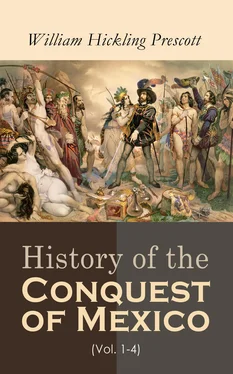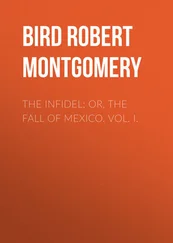[98]The Hon. Mountstuart Elphinstone has fallen into a similar train of thought, in a comparison of the Hindoo and Greek mythology, in his History of India, published since the remarks in the text were written. (See Book I. ch. 4.) The same chapter of this truly philosophic work suggests some curious points of resemblance to the Aztec religious institutions, that may furnish pertinent illustrations to the mind bent on tracing the affinities of the Asiatic and American races.
[99]Ritter has well shown, by the example of the Hindoo system, how the idea of unity suggests, of itself, that of plurality. History of Ancient Philosophy, Eng. trans. (Oxford, 1838), Book II. ch. 1.
[100]Sahagun, Hist. de Nueva-España, lib. 6, passim.—Acosta, lib. 5, ch. 9.—Boturini, Idea, p. 8, et seq.—Ixtlilxochitl, Hist. Chich., MS., cap. 1.—Camargo, Hist. de Tlascala, MS.—The Mexicans, according to Clavigero, believed in an evil Spirit, the enemy of the human race, whose barbarous name signified “Rational Owl.” (Stor. del Messico, tom. ii. p. 2.) The curate Bernaldez speaks of the Devil being embroidered on the dresses of Columbus’s Indians, in the likeness of an owl. (Historia de los Reyes Católicos, MS., cap. 131.) This must not be confounded, however, with the evil Spirit in the mythology of the North American Indians (see Heckewelder’s Account, ap. Transactions of the American Philosophical Society, Philadelphia, vol. i. p. 205), still less with the evil Principle of the Oriental nations of the Old World. It was only one among many deities, for evil was found too liberally mingled in the natures of most of the Aztec gods—in the same manner as with the Greeks—to admit of its personification by any one.
[101]Sahagun, Hist. de Nueva-España, lib. 3, cap. 1, et seq.—Acosta, lib. 5. ch. 9.—Torquemada, Monarch. Ind., lib. 6, cap. 21.—Boturini, Idea, pp. 27, 28.—Huitzilopochtli is compounded of two words, signifying “humming-bird,” and “left,” from his image having the feathers of this bird on its left foot (Clavigero, Stor. del Messico, tom. ii. p. 17); an amiable etymology for so ruffian a deity.{*}—The fantastic forms of the Mexican idols were in the highest degree symbolical. See Gama’s learned exposition of the devices on the statue of the goddess found in the great square of Mexico. (Descripcion de las Dos Piedras (México, 1832), Parte 1, pp. 34-44.) The tradition respecting the origin of this god, or, at least, his appearance on earth, is curious. He was born of a woman. His mother, a devout person, one day, in her attendance on the temple, saw a ball of bright-colored feathers floating in the air. She took it, and deposited it in her bosom. She soon after found herself pregnant, and the dread deity was born, coming into the world, like Minerva, all armed,—with a spear in the right hand, a shield in the left, and his head surmounted by a crest of green plumes. (See Clavigero, Stor. del Messico, tom. ii. p. 19, et seq.) A similar notion in respect to the incarnation of their principal deity existed among the people of India beyond the Ganges, of China, and of Thibet. “Budh,” says Milman, in his learned and luminous work on the history of Christianity, “according to a tradition known in the West, was born of a virgin. So were the Fohi of China, and the Schakaof of Thibet, no doubt the same, whether a mythic or a real personage. The Jesuits in China, says Barrow, were appalled at finding in the mythology of that country the counterpart of the Virgo Deipara.” (Vol. i. p. 99, note.) The existence of similar religious ideas in remote regions, inhabited by different races, is an interesting subject of study, furnishing, as it does, one of the most important links in the great chain of communication which binds together the distant families of nations.
{*} [The name may possibly have referred to the whispered oracles and intimations in dreams—such as “a little bird of the air” is still fabled to convey—by which, according to the legend, the deity had guided his people in their migrations and conquests. That it had a symbolical meaning will hardly be doubted, and M. Brasseur de Bourbourg, who had originally explained it as “Huitzil the Left-handed,”—the proper name of a deified hero with the addition of a descriptive epithet,—has since found one of too deep an import to be briefly expounded or easily understood. (Quatre Lettres sur le Mexique (Paris, 1868), p. 201, et al.) Mexitl , another name of the same deity, is translated “the hare of the aloes.” In some accounts the two are distinct personages. Mythological science rejects the legend, and regards the Aztec war-god as a “nature-deity,” a personification of the lightning, this being a natural type of warlike might, of which the common symbol, the serpent, was represented among the decorations of the idol. (Myths of the New World, p. 118.) More commonly he has been identified with the sun, and Mr. Tylor, while declining “to attempt a general solution of this inextricable compound parthenogenetic deity,” notices the association of his principal festival with the winter’s solstice, and the fact that his paste idol was then shot through with an arrow, as tending to show that the life and death of the deity were emblematic of the year’s, “while his functions of war-god may have been of later addition.” Primitive Culture, tom. ii. 279.—K.]
[102][For the Aztec myths our most valuable authority is the Historia de los Méxicanos por sus Pinturas, by Ramirez de Fuen-leal. This is taken directly from the sacred books of the Aztecs as explained by survivors of the Conquest. Bandelier, Archæological Tour, calls it the earliest statement of the Nahua myths. The other “sources” are Motolinía, Mendieta, Sahagun, Ixtlilxochitl, and Torquemada. Bancroft, Native Races, vol. iii. ch. 7, sums them up admirably.
Brinton, Myths of the New World, thinks Quetzalcoatl “a pure creature of the fancy.” Bandelier, whose presentation of the subject is most full and complete (Archæological Tour), agrees with Prescott that Quetzalcoatl began his career as leader of a migration southward. His principal sojourn was at Cholula. See also Payne, New World Called America, vol. i. pp. 588-596. P. de Roo, History of America before Columbus, vol. i. ch. xxii and xxiii, gives a very full presentation of the legend. He writes from the point of view of a priest of the Roman Catholic Church. His conclusion is that Quetzalcoatl was a Christian prelate, and that Christian doctrines were introduced into aboriginal America by European immigrants.—M.]
[103]Codex Vaticanus, Pl. 15, and Codex Telleriano-Remensis, Part 2, Pl. 2, ap. Antiq. of Mexico, vols. i., vi.—Sahagun, Hist. de Nueva-España, lib. 3, cap. 3, 4, 13, 14.—Torquemada, Monarch. Ind., lib. 6, cap. 24.—Ixtlilxochitl, Hist. Chich., MS., cap. 1.—Gomara, Crónica de la Nueva-España, cap. 222, ap. Barcia, Historiadores primitivos de las Indias Occidentales (Madrid, 1749), tom. ii.—Quetzalcoatl signifies “feathered serpent.” The last syllable means, likewise, a “twin;” which furnished an argument for Dr. Siguenza to identify this god with the apostle Thomas (Didymus signifying also a twin), who, he supposes, came over to America to preach the gospel. In this rather startling conjecture he is supported by several of his devout countrymen, who appear to have as little doubt of the fact as of the advent of St. James, for a similar purpose, in the mother-country. See the various authorities and arguments set forth with becoming gravity in Dr. Mier’s dissertation in Bustamante’s edition of Sahagun (lib. 3, Suplem.), and Veytia (tom. i. pp. 160-200). Our ingenious countryman McCulloh carries the Aztec god up to a still more respectable antiquity, by identifying him with the patriarch Noah. Researches, Philosophical and Antiquarian, concerning the Aboriginal History of America (Baltimore, 1829), p. 233.{*}
Читать дальше












